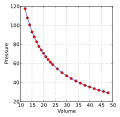Boyle's law
Boyle's Law is a fundamental principle in physics and chemistry, specifically within the sub-disciplines of physical chemistry and gas laws. Named after physicist and chemist Robert Boyle, this law describes the inversely proportional relationship between the absolute pressure and volume of a gas, if the temperature is kept constant within a closed system.
History[edit]
Robert Boyle (1627–1691), an Irish-born scientist who was a key figure in the 17th century scientific revolution, first stated the law in 1662. Boyle's experiments with gases led to the development of what we now know as Boyle's Law. His findings were published in the work New Experiments Physico-Mechanicall, Touching the Spring of the Air, and its Effects.
Statement of Boyle's Law[edit]
Boyle's Law can be stated as: At constant temperature for a fixed mass, the absolute pressure and the volume of a gas are inversely proportional. Mathematically, this can be represented as:
- P ∝ 1/V
- P = k(1/V)
where:
- P is the pressure of the gas.
- V is the volume of the gas.
- k is a constant value representative of the temperature and volume of the system.
Applications of Boyle's Law[edit]
Boyle's Law has numerous applications in real-life scenarios and various fields such as meteorology, human physiology, and engineering. For instance, it is used in calculating the air pressure change in scuba diving and understanding the behavior of gases in aerospace engineering.
See Also[edit]
References[edit]
<references />
Boyle's law[edit]
-
Boyles Law animated
-
Boyles Law
-
Boyle's Law Demonstrations
Ad. Transform your life with W8MD's Budget GLP-1 injections from $75


W8MD offers a medical weight loss program to lose weight in Philadelphia. Our physician-supervised medical weight loss provides:
- Weight loss injections in NYC (generic and brand names):
- Zepbound / Mounjaro, Wegovy / Ozempic, Saxenda
- Most insurances accepted or discounted self-pay rates. We will obtain insurance prior authorizations if needed.
- Generic GLP1 weight loss injections from $75 for the starting dose.
- Also offer prescription weight loss medications including Phentermine, Qsymia, Diethylpropion, Contrave etc.
NYC weight loss doctor appointmentsNYC weight loss doctor appointments
Start your NYC weight loss journey today at our NYC medical weight loss and Philadelphia medical weight loss clinics.
- Call 718-946-5500 to lose weight in NYC or for medical weight loss in Philadelphia 215-676-2334.
- Tags:NYC medical weight loss, Philadelphia lose weight Zepbound NYC, Budget GLP1 weight loss injections, Wegovy Philadelphia, Wegovy NYC, Philadelphia medical weight loss, Brookly weight loss and Wegovy NYC
|
WikiMD's Wellness Encyclopedia |
| Let Food Be Thy Medicine Medicine Thy Food - Hippocrates |
Medical Disclaimer: WikiMD is not a substitute for professional medical advice. The information on WikiMD is provided as an information resource only, may be incorrect, outdated or misleading, and is not to be used or relied on for any diagnostic or treatment purposes. Please consult your health care provider before making any healthcare decisions or for guidance about a specific medical condition. WikiMD expressly disclaims responsibility, and shall have no liability, for any damages, loss, injury, or liability whatsoever suffered as a result of your reliance on the information contained in this site. By visiting this site you agree to the foregoing terms and conditions, which may from time to time be changed or supplemented by WikiMD. If you do not agree to the foregoing terms and conditions, you should not enter or use this site. See full disclaimer.
Credits:Most images are courtesy of Wikimedia commons, and templates, categories Wikipedia, licensed under CC BY SA or similar.
Translate this page: - East Asian
中文,
日本,
한국어,
South Asian
हिन्दी,
தமிழ்,
తెలుగు,
Urdu,
ಕನ್ನಡ,
Southeast Asian
Indonesian,
Vietnamese,
Thai,
မြန်မာဘာသာ,
বাংলা
European
español,
Deutsch,
français,
Greek,
português do Brasil,
polski,
română,
русский,
Nederlands,
norsk,
svenska,
suomi,
Italian
Middle Eastern & African
عربى,
Turkish,
Persian,
Hebrew,
Afrikaans,
isiZulu,
Kiswahili,
Other
Bulgarian,
Hungarian,
Czech,
Swedish,
മലയാളം,
मराठी,
ਪੰਜਾਬੀ,
ગુજરાતી,
Portuguese,
Ukrainian



